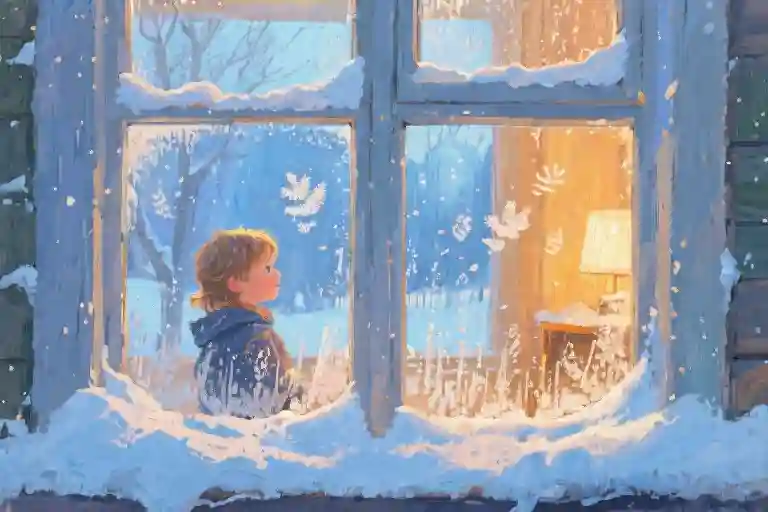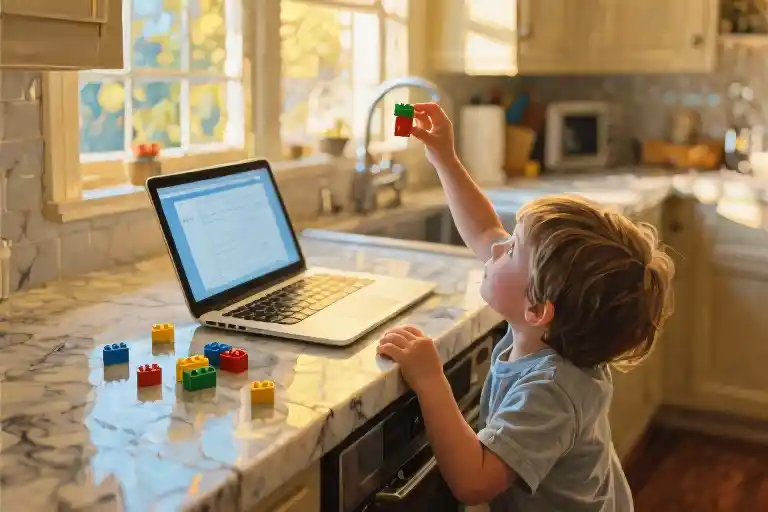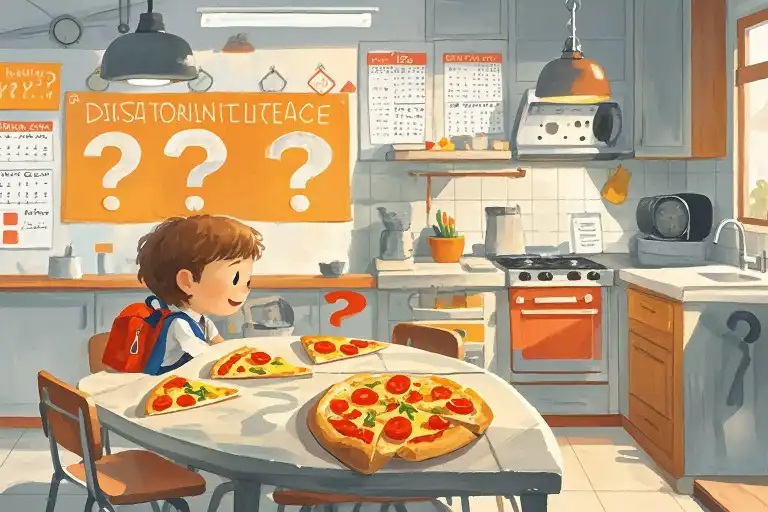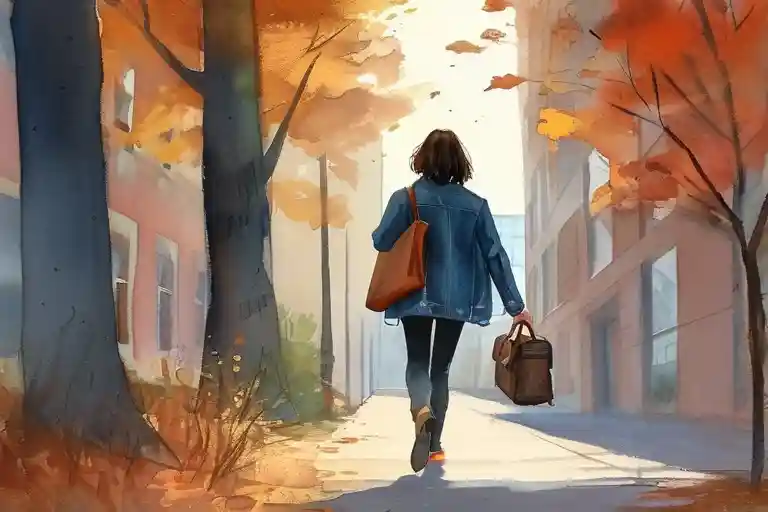The blue-eyed boy in Mary Cassatt’s portrait wears the expression of someone who has lived decades beyond his twelve years. His gaze holds something unchildlike – not quite sadness, not quite wisdom, but the quiet weight of experience no child should bear. That particular quality of light in his eyes makes you pause. It’s the same look I saw on my son Jason’s face the night before his thirteenth birthday, when a winter storm kept him home from school.
January 4, 2018. The digital clock on our microwave blinked 10:00 PM as snow piled against the kitchen window. School had been canceled – the first day back after Christmas break lost to swirling winds and icy roads. Upstairs, Jason moved quietly in his room, unaware of the camera waiting in our closet. That unopened box contained more than a birthday gift; it held the promise of how he might begin to make sense of the world through his own lens.
What fascinates me now, tracing the memory of that night, is how art and life mirror each other. Cassatt’s painting shows us a child shouldering invisible burdens, just as our children often do without our realizing. The boy’s formal attire and composed posture suggest adulthood imposed too soon, much like how Jason had started checking weather apps compulsively that winter, worrying about his friend Yuhan’s flight back from Beijing.
There’s a particular cruelty to childhood’s stolen moments – when playtime gives way to responsibility, when laughter gets replaced by that quiet, watchful look. The portrait captures it perfectly: the way children absorb the world’s complexities long before they have the tools to process them. That night, watching snow accumulate on the patio furniture, I understood why artists like Cassatt return to these transitional moments again and again. They remind us that growing up isn’t gradual; it happens in sudden leaps during ordinary nights when the world outside rages quietly, and inside, a child’s eyes reflect back more than we expect to see.
The Childhood Framed
Mary Cassatt’s blue-clad boy stares out from the canvas with a gaze that contradicts every expectation of childhood. At twelve—the same age my Jason would turn tomorrow—his hands rest too stiffly on his lap, fingers curled like they’re bracing against some unseen weight. Art historians call this portrait atypical for its era, and not just because Cassatt rejected the era’s saccharine depictions of children. Seven technical choices betray its psychological depth:
- The off-center composition, leaving empty space where toys should be
- Shadow pooling beneath the collar bones rather than apple-cheeked highlights
- Brushstrokes mimicking adult portraiture in the jawline definition
- A muted palette where contemporaries used candy-box colors
- Eyes reflecting window light but no discernible light source within the frame
- One shoe slightly untied—the only concession to childhood carelessness
- The chair’s carved armrests echoing prison bar shadows across his sleeves
Child psychologists would later identify these as classic defensive postures in prematurely mature children. That rigid spine mirrors what Dr. Elena Torres calls “the invisible backpack” phenomenon—when children unconsciously carry family stresses in their posture. The 1880s context adds another layer: this was an era when American factories employed over a million children under fifteen. Cassatt, though painting French bourgeoisie, likely witnessed similar pressures during her Philadelphia childhood.
What fascinates me isn’t just how Jason’s winter break posture unknowingly mirrored this painting—elbows tight to his sides while scrolling through Yuhan’s WeChat updates—but how art collapses time. That blue-clad boy’s defensive hand position? Jason adopted it exactly when the school closure notice pinged on my phone, his fingers suddenly rigid around his iPad. Centuries apart, both reactions whispered the same truth: childhoods interrupted don’t crumble dramatically. They fossilize in small gestures.
The historical irony stings. Cassatt’s patrons commissioned portraits to showcase privilege, never realizing how their parenting choices seeped into the brushstrokes. Now parents like me scrutinize these same paintings for warning signs, our smartphones filled with art therapy articles instead of gallery tickets. That untied shoe in the portrait? Last week I noticed Jason’s left sneaker perpetually loose despite his usual precision, the laces dangling like unasked questions.
The Time Capsule in the Closet
The camera sat in its box like a silent promise, wrapped in layers of tissue paper that crinkled when my husband shifted it deeper into the winter coat pocket. He’d spent forty-five minutes at the camera store that afternoon, caught in that particular male ritual of technical deliberation with the sales associate.
“The 50mm prime lens captures more natural perspective for portraits,” the clerk had insisted, wiping fingerprints off the display case with his sleeve. “But kids these days want zoom—makes them feel like wildlife photographers.” Their conversation looped through aperture ranges and image stabilization while outside, the season’s first proper snow began erasing the parking lot lines.
That unopened Nikon contained more than optical components. It held the weight of our parental hopes—that Jason might frame his world through something other than smartphone screens, that he’d learn to wait for the right light instead of snapping instant gratification. The camera’s leather strap still smelled faintly of factory treatments, an aroma that somehow bridged childhood’s plastic toys and adult tools of craft.
On the dresser in Jason’s room, a different collection of optics gathered dust: the toy binoculars from his seventh birthday, the kaleidoscope from a museum gift shop, even the broken viewfinder from last summer’s disposable camera. These were the relics of his ongoing visual exploration, arranged with the same care some boys devote to baseball cards or rock collections. The parallel wasn’t lost on me—where Mary Cassatt’s subject clutched a carved wooden horse, our son curated lenses. Both objects spoke of hands seeking to hold what the eyes couldn’t contain.
Outside, the snow measured its progress against the porch railing in methodical increments. Six inches by nightfall, nine predicted by morning—Jason’s thirteenth birthday would wake to a world softened under white. The weather app on my phone displayed competing countdowns: 14 hours until birthday pancakes, 36 hours until Yuhan’s flight back from Beijing, 62 hours until the rescheduled school photo club meeting. Time compressed and expanded like a camera’s iris adjusting to changing light.
We’d chosen this particular model because it mirrored Yuhan’s equipment—a practical consideration for their shared hobby, though the psychology wasn’t lost on us. At fifteen, Yuhan carried himself with the quiet assurance of someone who’d navigated airport immigration lines alone since sixth grade. If some of that composure rubbed off through their photography outings, we wouldn’t complain. The camera store clerk had nodded approvingly when my husband mentioned the mentorship angle: “Good call. Kids learn depth of field faster when they’re teaching each other.”
The closet door muffled the box’s presence imperfectly. Every time Jason passed by to fetch his snow boots or grab a sweatshirt, the gift seemed to hum with potential energy. He’d pause sometimes, head cocked toward the coats as if sensing the disruption in the domestic force field. We held our breaths during these moments, our parental poker faces barely masking the glee of conspirators. The anticipation became its own kind of present—the delicious limbo between secret and revelation that childhood too rarely gets to savor.
Through the window, the streetlights cast cones of amber through falling snow, creating the very effect Jason loved to photograph—what he called “time made visible.” I thought of Cassatt’s brushstrokes rendering the play of light on her subject’s blue sleeve, how both art and parenting involve learning when to sharpen details and when to leave things suggestively blurred. The camera waiting in the dark would soon expose its first frames, just as the birthday morning would expose new dimensions in the boy we were still learning to see.
The Visual Diary of a Snow Day
Jason’s bedroom window became his viewfinder that stormy afternoon. The way he framed each shot revealed more than technical skill – the slight downward tilt of his camera matched the weighted gaze we’d later notice in Cassatt’s portrait. His snow series showed a preoccupation with textures: the feathering of frost on glass, the crumpled fabric of snowdrifts, light catching the edges of icicles like undeveloped film edges.
What struck me wasn’t his composition choices but the rhythm of his shooting. Three rapid clicks, then long pauses staring at the LCD screen. Our art teacher Ms. Calloway would later explain this pattern during our interview: “Teens with emotional weight often shoot this way – bursts of expression followed by intense self-evaluation. In our mixed-age classes, older students actually model this editing process for younger ones.”
The safety of that classroom environment came through in Jason’s willingness to share imperfect shots. Where Cassatt’s children often appear stiff in their formal dresses and posed settings, our digital arts classroom thrives on what Ms. Calloway calls “beautiful accidents” – the overexposed lens flare that becomes artistic intention, the unexpected shadow that tells a better story.
Comparing Jason’s snow photos to Cassatt’s domestic scenes highlights a crucial difference. While the 19th century painter’s subjects are often trapped within the frame’s boundaries – hands carefully placed, postures corrected – today’s youth use photography to claim space. That storm day, Jason’s camera became a passport rather than a prison. His series included a defiant self-portrait reflection in the iced window, the glass simultaneously containing and freeing his image.
Yuhan’s influence showed in the Beijing-inspired compositions – tight crops on single snow-laden branches recalling Chinese ink paintings, high-contrast shots that echoed his friend’s urban photography style. This visual conversation across continents demonstrates what modern art education achieves: not the perfect replication of masters like Cassatt, but the authentic exchange of perspectives across cultures and generations.
The unopened camera in our closet took on new meaning as I watched Jason work with his old point-and-shoot. Sometimes the tools we withhold accidentally become the space where creativity flourishes. Like Cassatt’s subjects who found ways to express individuality within strict conventions, children will always find methods to develop their emotional exposures – with or without the equipment we think they need.
The Beijing-Chicago Darkroom Project
Yuhan’s photographs from Beijing arrived in fragments during those snowbound days, each image a puzzle piece of a world Jason couldn’t touch. The red paper cuttings pasted on his grandmother’s windows weren’t mere decorations – they were visual translations of 岁岁平安 (suìsuì píng’ān), that untranslatable wish for ‘peace in every year’. His camera had captured what his limited Mandarin couldn’t express: the way generations gather around circular tables, how steamed fish always faces the eldest relative, the particular red of lucky money envelopes against winter coats.
What fascinated me wasn’t just the cultural content, but the compositional choices. While Jason framed his snow photos with careful thirds-rule precision, Yuhan’s shots burst with purposeful asymmetry – a half-visible ancestor portrait here, a deliberately cropped lion dance costume there. Their photography teacher later explained this wasn’t technical deficiency but cultural grammar: ‘Chinese aesthetics often value suggestion over completeness, just like their classical poetry.’
Their friendship moved through three distinct phases we came to recognize:
- Novelty Exchange (Months 1-4): The obvious symbols – Great Wall snapshots for Sears Tower postcards, dumpling-making tutorials exchanged for baseball game videos. This was tourism brochure communication.
- Visual Translation (Months 5-9): When Yuhan started photographing Chicago’s alleyways instead of landmarks, when Jason began noticing how light fell differently through paper lanterns versus neon signs. This was the language of shadows and angles.
- Shared Syntax (Months 10+): That remarkable moment when their separate photo series on ‘thresholds’ – Yuhan’s shots of courtyard gates, Jason’s focus on school locker doors – showed identical use of shallow depth of field to blur what lies beyond. They’d developed a visual creole.
Digital tools accelerated this evolution in ways our generation can scarcely comprehend. When Jason struggled to explain ‘snow day excitement’, he didn’t reach for dictionaries but sent a 10-second clip of his boots crunching across the yard. Yuhan responded not with vocabulary lists but a slowed-down video of his cousin writing 雪 (xuě) in calligraphy, brush bristles flaring like the snowflakes outside our window. Their shared camera roll became more than an album – it was a living language lab where emojis, GIFs, and color filters conveyed what words couldn’t.
What startled me most was realizing these image-based exchanges were changing how both boys thought. Jason started describing flavors as ‘high saturation’ or ‘low contrast’. Yuhan reported dreaming in ‘cut scenes’ rather than continuous narratives. Their photography teacher nodded knowingly: ‘The smartphone generation doesn’t just use images, they cognitively process through them. Your son doesn’t remember events – he recalls them.’
That winter, I finally understood why the camera gift mattered more than we’d anticipated. It wasn’t about nurturing hobbyists but providing passports. Every shutter click was a border crossing.
The Unexposed Frames of Growth
The weather report that morning confirmed what we already knew – the storm had no intention of relenting. Thirteen inches of snow and counting, the kind of winter event that makes the world pause. Our kitchen window framed a scene straight from a snow globe, the kind of picturesque chaos that makes children press their noses against glass. Except Jason wasn’t watching. He sat at the breakfast table methodically peeling an orange, his fingers working with the same careful precision he used when adjusting camera settings.
That unopened camera box still waited in our bedroom closet. We’d planned the perfect birthday reveal – pancakes shaped like aperture symbols, his father pretending to ‘accidentally’ find the gift while fetching sweaters. But the storm had reshuffled our expectations like a deck of cards. School closures meant no Digital Arts class reunion with Yuhan. The blizzard warnings canceled the downtown photo walk we’d secretly arranged. Even the simple act of candlelight became complicated when the power flickered uncertainly.
I watched Jason scroll through Yuhan’s social media updates from Beijing. The time difference meant his friend’s Lunar New Year celebrations were just ending as ours began. There was something poetic about it – two boys separated by fourteen time zones yet connected through shared passion. Yuhan had posted a series of red lanterns against grey winter skies, the crimson hues so vibrant they seemed to defy the laws of nature. Jason’s fingers hovered over the screen, tracing compositions only he could see.
Later, when the wind howled particularly fierce against the siding, we abandoned our planned surprises. My husband simply brought out the camera box and set it beside Jason’s half-eaten birthday cake. No fanfare, no clever presentation – just a black rectangle with a red bow, slightly dented from its long concealment. The moment held its breath as Jason’s fingers found the seam of the packaging. Then the power went out completely.
In the sudden darkness, the only light came from the faint glow of Jason’s phone screen, illuminating his face the way Rembrandt might have painted it – all shadows and highlights, the angles suddenly sharper than they’d been at breakfast. The storm outside created a peculiar acoustics, muffling some sounds while amplifying others. I heard the crinkle of wrapping paper, the soft click of the box opening, then nothing.
‘It’s perfect,’ Jason said finally, his voice measured in that new way he had lately. Not the squealing delight of childhood birthdays, but something quieter, deeper. The kind of gratitude that comes from being truly seen. Through the window, the snow continued its silent assault, erasing footprints before they could fully form.
We never did get that perfect birthday photo. No grinning boy holding shiny new equipment, no carefully staged ‘first shot’ moment. Just the memory of a dim kitchen where the storm outside became irrelevant for a while, where the act of receiving a gift felt more significant than using it. Sometimes growth happens in these unrecorded intervals – between the planned celebrations and expected milestones, in the quiet space after the flash fires but before the shutter closes.
The invitation stands: what childhood moment would you choose to preserve in your mental darkroom? Not the obvious milestones, but those unassuming instants when you realized someone had been paying closer attention than you thought? The kind of moment Mary Cassatt might have painted – ordinary on the surface, heavy with unspoken understanding beneath?
The Unexposed Frames of Growth
The gallery wall holds two images side by side: Mary Cassatt’s full portrait of the boy in blue, and a smartphone snapshot of Jason making snow angels during last year’s winter break. The contrast couldn’t be more striking – one child’s gaze heavy with unspoken burdens, another’s face alight with momentary joy. Yet both share that peculiar duality of childhood where innocence and wisdom perform their uneasy dance.
This juxtaposition forces us to confront the central question that has threaded through our exploration: Are we documenting growth or merely bearing witness to its gradual erosion? The camera we never got to present that stormy night becomes more than a gift; it transforms into a metaphor for all the parental attempts to preserve what time inevitably alters.
Child development specialists remind us that maturation isn’t a linear process but rather a series of exposures – some deliberately captured, others occurring beyond our frame of vision. The photograph Jason might have taken with his new camera would show one version of reality, while Cassatt’s brushstrokes reveal another equally valid truth about childhood experience.
For families navigating similar crossroads, several resources offer guidance:
- The International Youth Art Exchange program connects teens across cultures through shared photography projects
- Growing Pains Foundation provides art therapy workshops specifically for prematurely mature children
- Digital Darkroom initiative pairs international students as creative mentors
Perhaps the most valuable takeaway isn’t about choosing between recording childhood or letting it flow unobserved, but rather recognizing when to put down the camera and simply be present. The unopened gift in our closet eventually found its way to Jason’s hands months later, just as Cassatt’s young subject likely grew into his knowing eyes. Both remind us that while we can’t stop the developing process, we can choose the lens through which we view it – whether that’s a painter’s meticulous oils, a parent’s loving gaze, or a child’s own emerging perspective behind the viewfinder.





